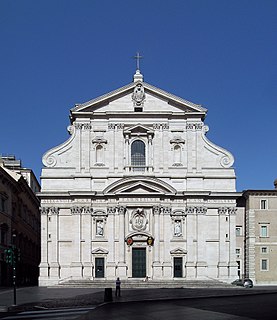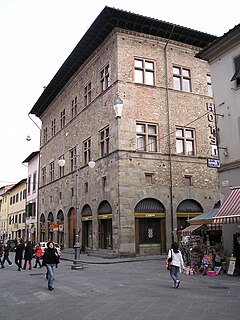
The province of Pistoia is a province in the Tuscany region of central Italy. Its capital is the city of Pistoia and the province is landlocked. It has an area of 964.12 square kilometres (372.25 sq mi) and a total population of 291,788 inhabitants. There are 22 communes in the province.

Giacinto Gimignani was an Italian painter, active mainly in Rome, during the Baroque period. He was also an engraver in aquaforte.

The Italian Catholic Diocese of Pescia is in Tuscany. It is a suffragan of the Archdiocese of Pisa.

San Giovanni Fuoricivitas is a Romanesque religious church and adjacent buildings in Pistoia, Tuscany, central Italy. The adjective fuoricivitas refers to it location, outside of the first set of city walls, when it was founded during the era of Lombard rule in Italy.

Palazzo Panciatichi or Palazzo del Balì is a medieval aristocratic palace located on Via Camillo Benso Cavour #35 in Pistoia, Tuscany, Italy. It a block away from the Palazzo Fioravanti.

Palazzo Tucci is an 18th-century palace in central Lucca, Region of Tuscany, Italy.
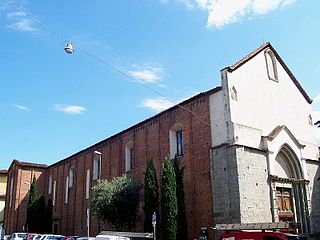
San Domenico is a Romanesque and Gothic-style, Roman Catholic church located in Pistoia, region of Tuscany, Italy.
Cassa di Risparmio di Pistoia e della Lucchesia is an Italian regional bank based in Pistoia, Tuscany. The bank was a subsidiary of Banca CR Firenze, with Intesa Sanpaolo as the ultimate holding company.

The Civic Museum of Palazzo Mosca is the main civic museum of Pesaro, displaying art and decorative works, located in Piazza Mosca in this town of the region of the Marche, Italy.
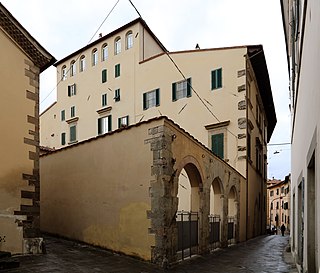
The Palazzo Sozzifanti also known as the Palazzo Buontalenti is a Renaissance-style palace located at the intersection of Via del Carmine, Via de' Rossi, Via Abbi Pazienza and Via Sant'Andrea in central Pistoia, Tuscany, Italy. The palace is used in 2019 as a temporary exhibition site by the Cassa di Risparmio di Pistoia and Pescia Foundation.
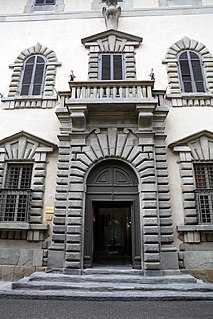
The Palazzo Ganucci Cancellieri is a late-Mannerist-style palace located at Via Curtatone e Montanara #51 in central Pistoia, Tuscany, Italy.
The Palazzo Fioravanti, formerly Palazzo Gherardi-Peraccini is a 15th-century early-Renaissance style palace located at Via Benso Cavour #20 in central Pistoia, Tuscany, Italy. It stands across the street from the north flank of the church of San Giovanni Fuorcivitas.
The Palazzo Puccini is a former aristocratic palace located at Via Can Bianco in central Pistoia, Tuscany, Italy. The palace is now used as a boutique guest house/residence.
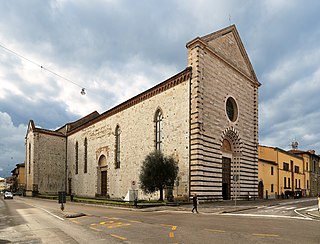
San Francesco is a Gothic-style, Roman Catholic church located on the piazza of the same name in Pistoia, region of Tuscany, Italy.
The Villa del Barone is a Renaissance style, rural aristocratic palace located in the rural neighborhood or frazione of Bagnolo di Sopra, located within the town limits of Montemurlo, province of Prato, region of Tuscany, Italy. The villa and the properties associated once belonged to the Tempi family, by the 16th century, it belonged to Baccio Valori, from whom it was confiscated by Cosimo de Medici. Cosimo granted it to the Rossi family. Later belonged to Vettori family.
The Villa Pazzi al Parugiano is a Renaissance style, rural aristocratic palace located in the rural neighborhood or frazione of Bagnolo, located within the town limits of Montemurlo, province of Prato, region of Tuscany, Italy. The word Parugiano appears to be dialect for Paludano or Pantano, meaning swampy. The villa is now privately owned and rented out for cultural functions and celebrations.
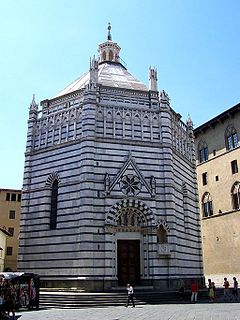
The San Giovanni in Corte Baptistery, also known as the Baptistery of San Giovanni di Rotondo, is a former Roman Catholic building in Pistoia, region of Tuscany, Italy. The octagonal baptistery stands at a slight angle across a small piazza from the Duomo of Pistoia in the center of town. It is presently used for cultural events.
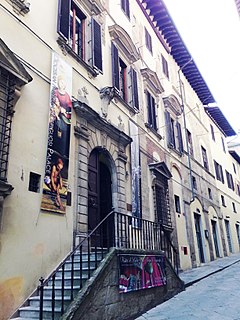
The Palazzo Rospigliosi a Ripa del Sale or Rospigliosi sulla Ripa is a former aristocratic palace located at Via Ripa del Sale number 3 in central Pistoia, Tuscany, Italy. The location is in a small alley adjacent to the Pistoia Cathedral, within the most ancient set of city walls. In the 19th century, the palace was donated to the diocese and now is used as both Diocesan museum and for the display of the collection donated by Clemente Rospigliosi.

The Palazzo Rospigliosi a Via del Duca is a former aristocratic palace located at Via Ripa del Sale number 3 in central Pistoia, Tuscany, Italy. The palace was the birthplace in 1600 of Giulio Rospiglio, later Pope Clement IX.

The Palazzo degli Anziani also known as the Palazzo del Comune or del Giano is a Gothic-style stone palace located in the ancient historic center of Pistoia, Tuscany, Italy. The palace served as city hall for centuries; it still belongs to the comune and now mainly houses the Museo Civico d'Arte Antica.

